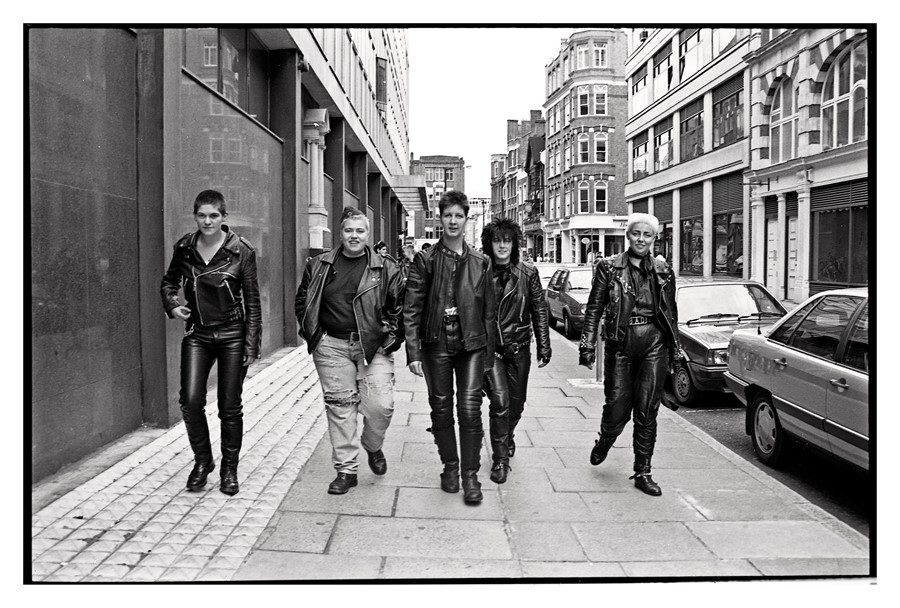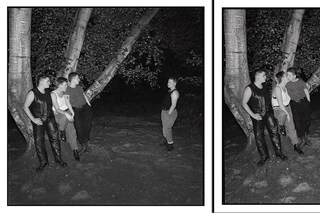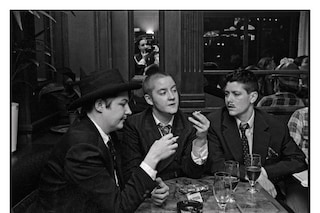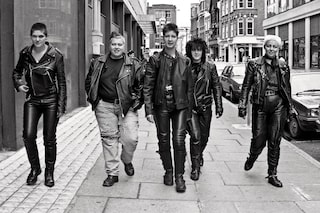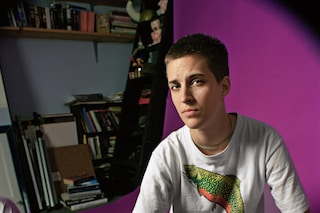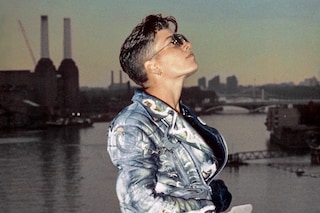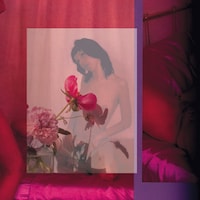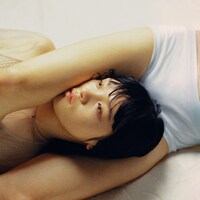The cult photographer known for documenting lesbian nightlife reflects on decades of making images that ‘rupture binary thinking’
“I’m quite used to being censored and sidelined,” American artist and activist Del LaGrace Volcano says upfront, remaining as determined and defiant as they ever were. For more than four decades, Volcano has blazed a singular path with camera in hand, working across photography, performance, and film to explore gender as a fluid space of masculine and feminine expression.
Hailing from Arroyo Grande, a small beach town in San Luis Obispo County, California, Volcano was born intersex in 1957, yet raised as a girl. “I was I wasn’t aware there was anything different about me but at puberty, my body didn’t develop the way I thought it would, a fact I tried to hide for a very long time,” says Volcano, now 66 years old.
Over the course of their life, Volcano has witnessed and helped shape the expanding landscape of gender in the 21st century. “I think gender is the last bastion of civilisation as we know it,” says Volcano. “The idea of there being two and only two valid biological sexes, that are required to comply with gender norms for male and female – that’s something people are grasping hold of for dear life. I’m all for anything that attempts to rupture the binary thinking, whether it’s black, white, male, female, queer, non-queer.”
Volcano set off on their journey after moving to San Francisco in the mid-1970s. The era was a whirlwind. They lived in the very studio that folk legend Janis Joplin shared with an unknown Jewish lesbian lover at The Goodman Building, an artist’s hotel. To support themselves, they worked for Green Street Mortuary as a motorcycle escort for Chinese funerals along with punk icon, Olga De Volga. Then they received a full California State scholarship to study photography at the San Francisco Art Institute from 1979 to 1981.
“I’m all for anything that attempts to rupture the binary thinking, whether it’s black, white, male, female, queer, non-queer” – Del LaGrace Volcano
“I was student body president even though I am NOT a student government type person. I didn’t run for office but was installed after they impeached their student body president for reasons I can’t remember,” says Volcano. “My short reign was all about hiring the Dead Kennedys, Romeo Void and giving Laurie Anderson an honourary doctorate so I could meet her and slam dancing with the wild boys. I was influenced by Larry Sultan and Reagan Louie, was my main tutor. But when I started making work about working-class sex-positive lesbian nightlife there was a shocking amount of homophobia directed towards me.”
Volcano took the name Della Grace in 1979, and was dubbed “Della Disgrace” the following year by now infamous tattooist, Aimee Ross, “THE Bearded Lady.” They began hanging out at Scott’s Bar, which they describe as “a working-class neighbourhood bar populated by all kinds of queer folk, from high femme sex workers and their butch dykes on bikes lovers.”
Here, Volcano began developing the foundational tenets of their practice, one rooted in the creation, collaboration, and community through intimate explorations of identity and art. “I’ve always had this need to connect with people, and that is what [the work is] about,” they say. “I have a way of people trusting me and letting me get close. It’s not something you can consciously do and it’s not something you can teach other people to do either.”
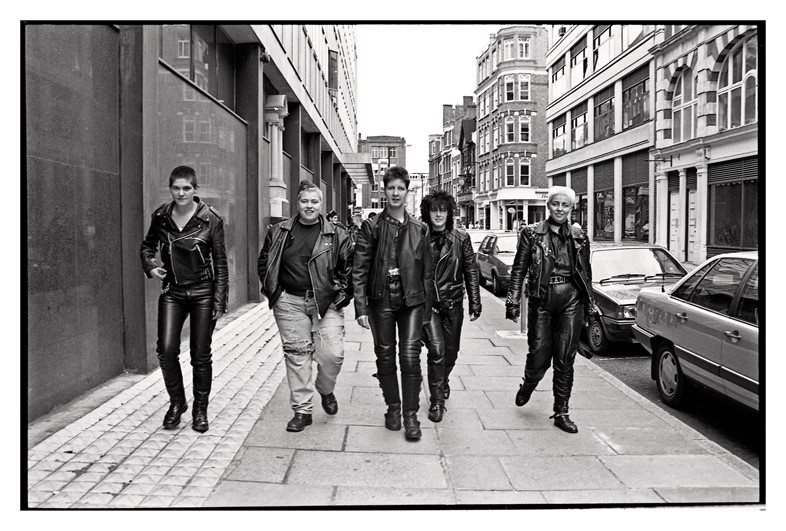
The lesbian nightlife series created a space for vulnerability and risk, yet it was stigmatised for portraying sex workers outside the prescribed confines of liberal politics. Instead, Volcano’s 1979 street photographs in the Mission District, a predominantly Latinx community, were hailed as “edgy” and they were seen as brave for going into a “dangerous neighbourhood.” The dubious double standard did not go unnoticed. “There was a class divide and as a queer working-class kid I felt pretty alienated by the rich kids who basically ruled the roost at SFAI.”
In 1981, Volcano dropped out of SFAI due to homophobia and embarked on a journey that would establish their place in photography history. After a cross-country motorcycle ride to New York, they immigrated to London in 1982, then back to San Francisco in ’84. They spent time photographing lesbians living on women’s land in Santa Fe, New Mexico, before returning to London in ’87, where the adventures continued when they joined the Chain Reaction Collective, a weekly BDSM lesbian club at The Market Tavern, Vauxhall – usually a leathermen venue.
Times were tough but they were young and having fun in a free and open polyamorous scene. “It was a great way to get to know people, actually,” Volcano says. Throughout it all, they made photographs chronicling moments of tenderness, pleasure, desire, and self-determination with fearless aplomb, creating an archive of the era. The photographs, collected in the Volcano’s 1991 debut monograph Love Bites (Gay Men’s Press) ignited a conservative furore with bookshops like Gays The Word, Silvermoon and Sisterwrite refusing to stock it. It was banned by US Customs but rescued by Teddy Kennedy, who was friends with the distributor Sasha Alyson of Alyson Books.
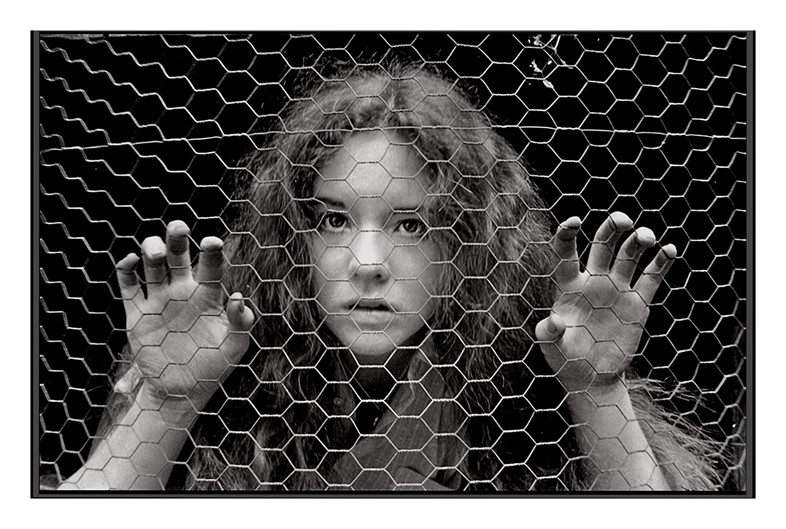
Three decades later, selections from this groundbreaking series are now on view in Women in Revolt! Art and Activism in the UK 1970–1990 at Tate Britain, placing Volcano’s intimate scenes of the lesbian underground BDSM scene alongside the radical work of their contemporaries including Caroline Coon, Linder, Cosey Fanni Tutti, and Marianne Elliott-Said (A.K.A Poly Styrene).
Using photography as a survival strategy, Volcano embraced self-portraiture as a space to experiment with identity as a construction of self. Throughout their life, the self-portrait has played an integral role in their journey to make visible that which has been erased: those living beyond the binary and defining gender, sexuality, and identity on their own terms.
In 1995, at age 37, Volcano decided to stop hiding their intersexiness and come out as both non-binary and intersex with their self-portrait, Del with a Blue Beard, on the cover of The Weekend Guardian. Shot in their home studio in Highbury Hill, London, Volcano stands before the camera, making direct eye contact, arms squared across their chest as they press the shutter release. Volcano reveals facial hair flawlessly manicured with blue mascara.
The self-portrait was accompanied by a profile by journalist Deborah Orr on the same day as they wed Johnny Volcano. “Thus Della Grace morphed into Del LaGrace Volcano,” they explain. It was a statement of pride and power in a culture that had prized Volcano’s theretofore femininity – and their open embrace of an expansive gender identity threatened the liberal status quo.
“A lot of great journalists loved me for the performance,” Volcano remembers. “I would wear wigs and be hyper-feminine mostly to hide being intersex, but when I let my beard grow without testosterone and just stopped trying to be only female in 1995, they were horrified. I was a bearded lady to them. It was like I had to be complicit in being a freak show, and if you’re not going to be pitied, then you have to be somehow exotic.”
Rather than collaborate, Volcano chooses to resist, preferring to maintain the integrity that has shaped their life’s work. Today they are living and working in Sweden, Germany and the UK and have two young and fabulous gender non-conforming children they co-parent with their ex-partner.
“I’m not a blue-chip artist because I have such radical anti-capitalist principles. I feel that I’m part of a queer diaspora that many queer people experience: of not being really included or valued in their biological family,” they say. “For me, creating a connection with people is also about creating family. It’s about having a feeling of belonging, being connected, and connecting other people together.”
Women in Revolt! Art and Activism in the UK 1970–1990 is on view until April 7, 2024 at Tate Britain in London.
Join Dazed Club and be part of our world! You get exclusive access to events, parties, festivals and our editors, as well as a free subscription to Dazed for a year. Join for £5/month today.
